
OUR HISTORY
The history of the Ukrainian Bandurist Chorus can be traced directly to the 12th Archeological Congress in Kharkiv, Ukraine, in 1902. It was here that Hnat Khotkevych, a writer, ethnographer, and composer, first formed an orchestra of kobzars. This performance stimulated growth in the bandura’s popularity at the beginning of the 20th century, and sighted and non-sighted bandura ensembles rapidly formed throughout the country.

Kobzars at the 12th Acheaological Congress in Kharkiv in 1902. Photo: Wikimedia Commons.

Kyiv Bandurist Cappella in 1925.
The first bandurist ensemble formed in Kyiv in 1918 during the height of the country’s brief period of independence. Under the direction of bandura virtuoso Vasyl Yemetz, the first ensemble initially had 8 members. Volodymyr Kabachok formed another such ensemble in Poltava in 1925.
The mid-1920s were marked by a period of resurgence of Ukrainian arts and culture, and the Ensemble developed into a professional touring troupe. The Kobzar Choir was re-constituted in December 1923 as the Kyiv Bandurist Kapella. Over time, the versatility of the bandura and the ensemble grew to accommodate more intricate arrangements of folk songs.

Poltava Bandurist Kapelle, 1925. Photo: Archives of the UBC.
In 1928, the political direction of Soviet Ukraine changed from Ukrainianization to oppression. The Ensemble’s history rapidly evolved into a turbulent one. The ideals of the bandurist — faith, truth, freedom, and human dignity heralded through song — were a threat to the new Soviet identity. Anti-Russian sentiment and anything reflecting religious undertones was eradicated. Under Joseph Stalin’s rule, artists and intellectuals were arrested, exiled or executed in an attempt to eradicate every remnant of Ukrainian culture.

Above: The State Exemplary ("Зразкова") Bandurist Kapella in 1937. Photo: Archives of the UBC.
Many conductors, Ensemble members, and blind bandurists-minstrels were charged with enticing the populace to Ukrainian patriotism and were arrested. In 1935, the remaining members were forced to reorganize into the State Bandurist Kapella of the Ukrainian SSR (Above). Hnat Khotkevych was executed in 1938 in Kharkiv, and his compositions and arrangements were removed from the repertoire of the Ensemble and banned throughout the Soviet Union.The Kapella's reportoire was changed to one that served the direction of the Marxist state — harmless entertainment and praise of the Communist party.
In the years that followed, the Ensemble was exploited and persecuted by both the Soviets and the Nazis. Under the Nazi occupation, the performance policies grew more restrictive. Not until after World War II was the Ensemble free to sing without censorship or the state's political "guidance." Through the assistance of allied forces, many in the Ensemble emigrated from refugee camps to the United States. The UBC established a new home in Detroit, Michigan.

The UBC in 1948. Photo: Archives of the UBC.
Freedom was a great blessing but it was not without its difficulties. Most of the members, in order to support their families, had to learn new skills that were often unrelated to their musical ability and experience. Approximately 90 percent joined Detroit’s automotive industry labor force. This, however, did not prevent the bandurists from launching a series of concerts in their newly adopted homeland. The UBC rehearsed on weekends and its members were paid during the time the Ensemble was on tour. The Ukrainian Bandurist Chorus was reborn.
Notwithstanding these difficulties in a new land, the Ukrainian Bandurist Chorus took part in concert tours throughout North America. In 1958 the Chorus embarked on a triumphant concert tour throughout Western Europe. The Ensemble performed in England, France, Germany, Switzerland, Spain, Belgium and the Netherlands, all while garnering critical acclaim in leading newspapers. Upon its return, the Ensemble continued its mission of sharing the beauty of the bandura with North American audiences.
During the 1960s and 1970s, the ensemble released many more recordings, continued giving concerts, and toured Australia in 1980. The late 1970s and 1980s also saw the educational involvement of the Chorus grow as it began sponsoring bandura seminars and summer music camps.

Hryhory Kytasty, (1907-1984, Left), long-standing conductor of the Ensemble was a driving force in re-instilling Ukrainian choral and bandura art in North America. Considered a legend in his own time, this composer, conductor, performer, and teacher was a role model and inspiration to young bandurists. He continued the legacy of the bandurist and furthered the art of the bandura in the free world.
Today, the majority of Ensemble members are 2nd and 3rd generation Americans and Canadians. Fortified by a whole new generation of young musicians, the Chorus has captivated audiences in major concert halls in the United States, Canada, Europe, Australia, and Ukraine for more than 50 years.
In June 1991, under the directorship of Wolodymyr Kolesnyk, the Ensemble completed a historically triumphant 14-city tour throughout major cities of Ukraine. The performances, which encompassed traditional ballads and instrumentals, were received with great enthusiasm and rave reviews, especially in areas of Ukraine where national consciousness had been most dormant.
As a tribute to its role in preserving and perpetuating the legacy of Ukrainian music, the Ensemble was selected by Ukraine’s Council of Ministers as the recipient of the Taras Shevchenko Ukrainian State Prize, the highest award that can be bestowed for excellence in the contribution to the arts. The Ensemble returned to Ukraine again in 1994, touring the russified regions of southern Ukraine and Crimea.
Under Artistic Director and Conductor Oleh Mahlay, the UBC celebrated its 50th Anniversary in North America in 1999. In the spring of 2001, the UBC presented a series of Sacred Music Concerts to various communities in North America. Returning to Ukraine for a third visit in August of 2001, the Ensemble had the distinct honor of representing the United States in Kyiv during Ukraine's 10th Anniversary of Independence Celebration. Performances were presented in various venues around Kyiv, including the Concert Palace of Ukraine and the U.S. Ambassador's Residence.
After a 45 year hiatus, the UBC returned to Western Europe in 2003 with a series of concerts in England, France, Germany, and Austria. One of the many highlights of the tour was a recital in the famed Notre Dame Cathedral in Paris.
From 2008 - 2009, the UBC worked under the directorship of Adrian Bryttan. Over the course of his term as Artistic Director and Conductor, Mr. Bryttan introduced innovative compositions to the extensive repertoire of the Ukrainian Bandurist Chorus.
In 2010, Maestro Bohdan Heryavenko was elected the Artistic Director and Conductor of the Ukrainian Bandurist Chorus. In his two years with the UBC, Maestro Heryavenko led the ensemble in a return performance at the internationally-renowned Stratford Summer Music Festival. In addition, he conducted the Western Canadian Concert Series of 2011 and directed the UBC for the 50th Anniversary Concert of St. Nicholas Ukrainian Catholic Eparchy in Chicago attended by his Beatitude Sviatoslav. The Maestro also conducted the benefit concert for the Ukrainian Language Studies Program at the University of Pittsburgh in October of 2011.
On August 1, 2012, Oleh Mahlay returned to the Ukrainian Bandurist Chorus as Artistic Director and Conductor.
Gallery: Before 1935
1902 — Kobzars at the 12th Archeological Conference, Kharkiv, Ukraine
Identities of musicians given in Ukrainski Dumy by Filaret Kolessa, published in Lviv in 1920, document courtesy of KytastyFoundation.org.

Top row from left: 1. Unknown musician. 2. Arsen Ostapenko ("Mova"), kobza-maker from Derkachiv village near Kharkiv. 3. Ivan Ostapenko (brother of Arsen). 4. Samson Veselyj, lirnyk.
Middle row from left: 1. Ivan Zozulia, lirnyk from Greater Danylivka, Kharkiv region. 2. Petro Drevchenko, kobzar from Zalyutyn near Kharkiv. 3. Tereshko Parkhomenko, kobzar from Burkivka, Chernihiv region. 4. Hnat Khotkevych, organizer of the kobzar conference. 5. Mykhailo Kravchenko, kobzar from Greater Sorochynets, Myrhorod district, Poltava region. 6. Pavlo Hashchenko, kobzar from Kharkiv region. 7. Larion. Unknown lirnyk.
Bottom row from left: Pavlo Kysil, the guide ("Povodator" or "Povodyr") of Drevchenko. 2. Ivan Netesa, kobzar from Old Merchkiv, Valks. district, Kharkiv region. Ivan Kuchurenko from Murafy, Bohodukhivsk distriction, Kharkiv region.

1908 — Student Bandurist Ensemble at Domontovych's estate.
From left: 1. Кашуба Марко Пилипович (1875—1934), 2. Копань Григорій Якович (1890—1937) 3. Панченко Федір Петрович, (без бандури) 4) Сидить Потапенко Василь Василєвич, 5) Яценко в капелюсі 6) Войцех Григорій Євтихович (1877—1937)

1925 — Kyiv Bandurist Kapella
Artistic Director:
Vasyl Yemetz
Members, not in order: М. Теліга, Григорій Андрійчик, Федір Панченко, Яків Цебренко, Сава Діброва, Григорій Копан, Андрій Слідюк

1925 — Kyiv Bandurist Kapella
1925 or 1928 — Kyiv Kapella in Kaniv, Ukraine

1927 — Poltava Bandurist Kapella

Photo source: Archives of the UBC.
First Row: Andrii Kononenko, Hryhorij Nazarenko, Yosyp Panasenko, Volodymyr Kabachok -- conductor, Yakiv Kladovii, Danylo Pika.
Second Row: Yakiv Protopopiv, Yurko Kolesnyk, Pavlo Miniailo, Oles Buldovskyi, Serhij Miniailo.

1934 — Kyiv Philharmonia Bandurist Kapella, just prior to its merging with the Poltava and Kyiv ensembles to form the State Exemplary Bandurist Kapella. Photo: Archives of the UBC.
First Row: O. Kostetskyi, Mykola Mykhailov -- Artistic Director, A. Andriichuk, O. Arov, T. Pivko (only member not eventually executed or disappeared by the Soviets)
Second Row: I. Tsybuliv, A Fedko, O. Shleiuk, Vasyl Pokhyl, Oleksii Dziubenko.
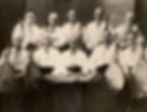
Caption as hand-written on the back of the photo, in English: Bandurists Chorus of Kiew Ukraine. 9.29.1933. First Row: Kostecky (tortured to death by NKVD), Mychajliw (conductor, died enigmatically in Middle Asia in 1936), Andrijczyk (sent away to Siberia and tortured to death), Arow (manager), T. Pivko (present member of Bandurists in Detroit). Second Row: Cybuliw (sent away to Siberia and tortured to death), Fedjko (" "), Shlejuk (" "), Pochyl (" "), Dzjubenko (" ").

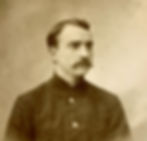
Conductor, Poltava Bandurist Kapelle. This photo, most likely from the 1920s, is in the UBC Archives.

Caption as hand-written on the back of the photo, in English: Bandurists Chorus of Kiew Ukraine. 9.29.1933. First Row: Kostecky (tortured to death by NKVD), Mychajliw (conductor, died enigmatically in Middle Asia in 1936), Andrijczyk (sent away to Siberia and tortured to death), Arow (manager), T. Pivko (present member of Bandurists in Detroit). Second Row: Cybuliw (sent away to Siberia and tortured to death), Fedjko (" "), Shlejuk (" "), Pochyl (" "), Dzjubenko (" ").
State Kapella (1935–1941)

1935/6 — Concert Poster
Archives of the UBC
This poster advertised a performance by the Ukrainian State Exemplary Bandurist Kapella, led by Mykola Mykhailov. Mykhailov died in 1936 in Tashkent on the Kapelle's tour of Central Asia.
The Administrator of the Ensemble in the late 1930s had the foreboding surname "Недоля," or "No-Fate." His name can be seen on the bottom-right of the poster.
Of this ensemble, only a few made it to freedom, among them Nazarenko, Kytasty, Miniajlo, and Panasenko.
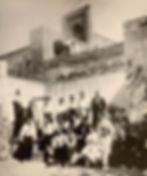
State Kapella in Baku, Azerbaijan, in 1936. Photo: UBC Archive.
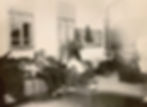
Waiting for a train on August 11, 1938, in Armavir, Kuban (a heavily-Ukrainian region of what is now Russia). Photo: UBC Archive.
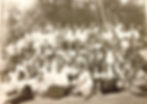
Relaxing in Tashkent on June 6, 1936. Note that this is the same stop on tour at which Mykola Mykhailov, the Artistic Director, died under mysterious circumstances. Photo: Pivko papers, UBC Archives.

State Kapella in Baku, Azerbaijan, in 1936. Photo: UBC Archive.
The War Years (1941–1945)
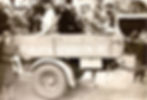
Hamburg Germany, November 23, 1942. Photo: UBC Archives.

Photo from Panasenko Papers, UBC Archives.

Rehearsing before a concert in Lviv, Ukraine, 1943. From left: Mykola Liskiwsky, Petro Kytasty, Ivan Kytasty, Yenhen Ciura, and _ Panasenko. Photo: UBC Archives, Panasenko papers.

Hamburg Germany, November 23, 1942. Photo: UBC Archives.
Free at Last (1945– )

1945 — Ukrainian Bandurist Chorus
Germany
Artistic Director:
Volodymyr Bozhyk

1946 — Ukrainian Bandurist Chorus
Ingolstadt, Germany
Artistic Directors:
Volodymyr Bozhyk and Hryhory Kytasty
First Row
Mykola Liskivskyj, Tymofij Pivko, Ivan Kytasty, Petro Potapenko, Volodymyr Bozhyk, Hryhory Kytasty, Yosyp Panasenko, Stefan Hanushevskyj, Yevhen Ciura, Mykhajlo Shrubovych.
Second Row
Mykola Samokyshyn, Dmytro Chernenko, Pavlo Miniajlo, Roman Stepaniak, Havrylo Makhynia, Dmytro Potoroka, Pavlo Talan, Ivan Stetsyk, Yulian Dukhnych, Mykola Pryplys.
Third Row
Lubomyr Lampika, Mykhajlo Minsky, Ivan Samokyshyn, Fedir Pohorilyj, Petro Motuz, Volodymyr Tysovskyj, Volodymyr Polishchuk, Ivan Oleshko, Oleksander Dejneka.
1949 — Ukrainian Bandurist Chorus
Regensburg Displaced Persons' Camp, Germany


1949 — Ukrainian Bandurist Chorus
Detroit, Michigan, United States
Artistic Director:
Hryhory Kytasty
First Row
Mykola Liskivskyj, Serhij Hryhorenko, Ivan Kytasty, Hryhory Kytasty, Yosyp Panasenko, Petro Kytasty, Petro Honcharenko.
Second Row
Pavlo Miniajlo, Petro Sadovyj, Volodymyr Tysowskyj, Fedir Pohorilyj, Oleksander Sadovyj, Dmytro Liubansky, Danylo Kravchenko.
Third Row
Avhustyn Malkovych, Zenon Miakhkyj, Taras Lozynskyj, Petro Motuz, Neal Reva, Havrylo Makhynia, Mykhajlo Shrubovych, Evhen Ciura.
Below: The UBC on its first U.S. tour in 1949–1950

.png)


